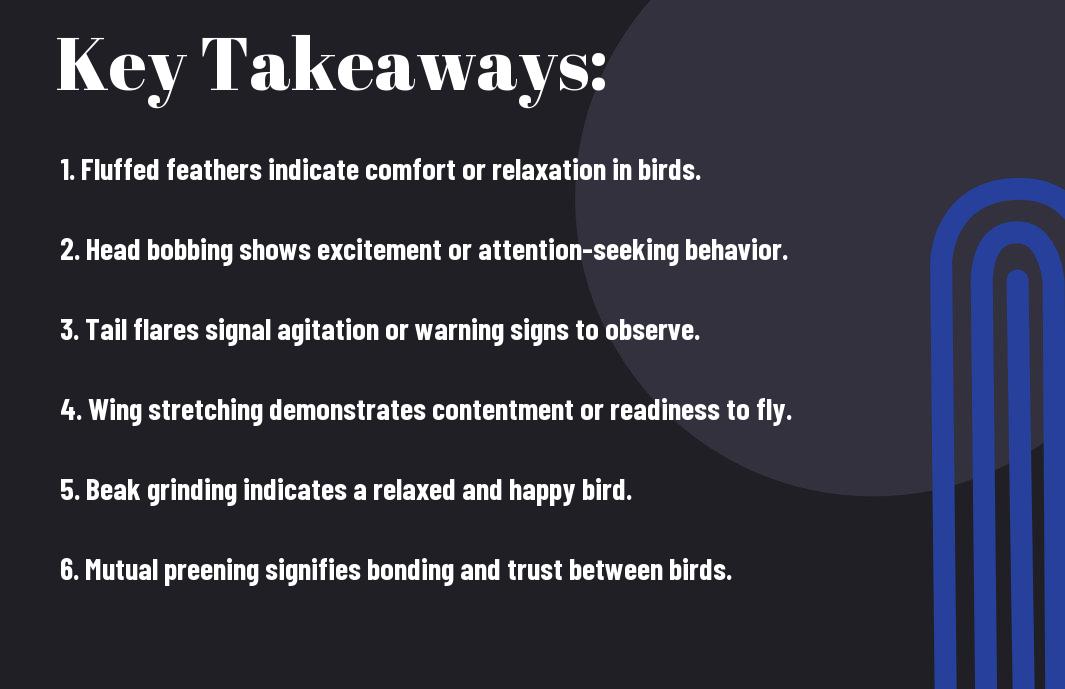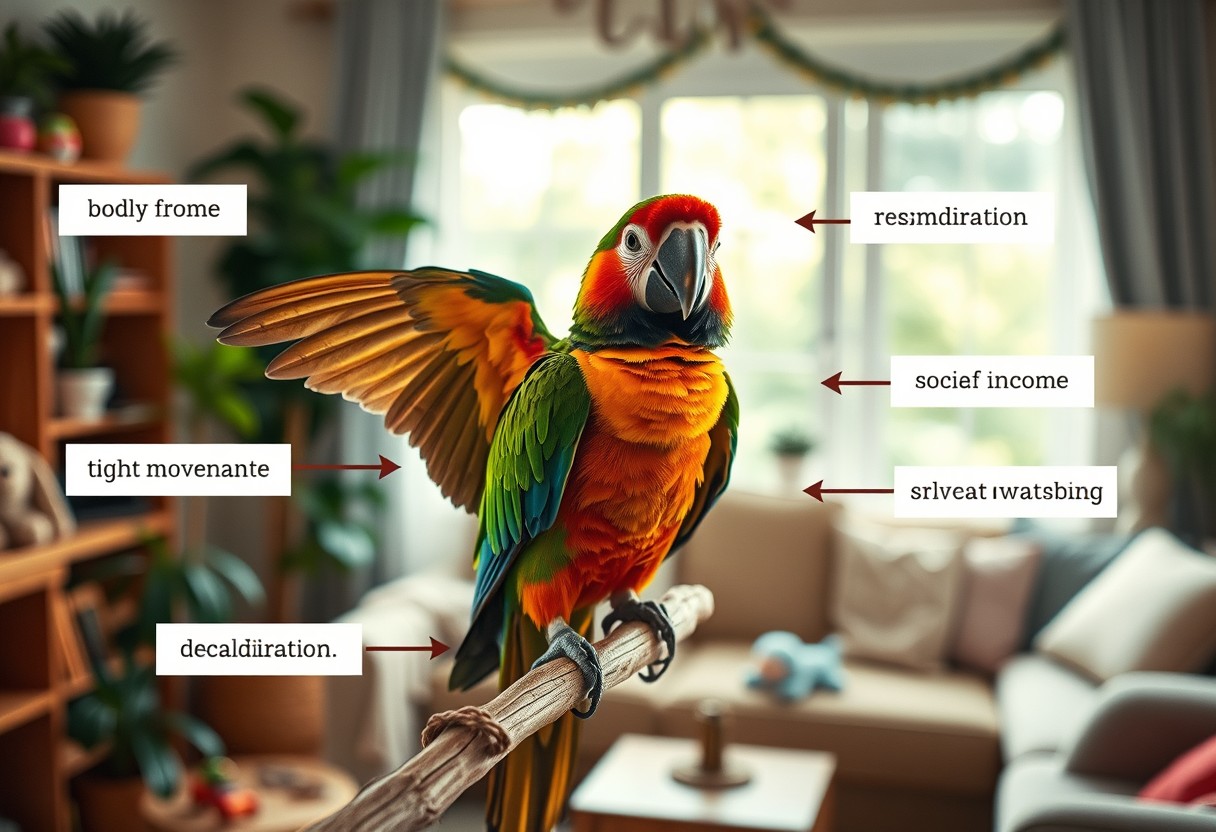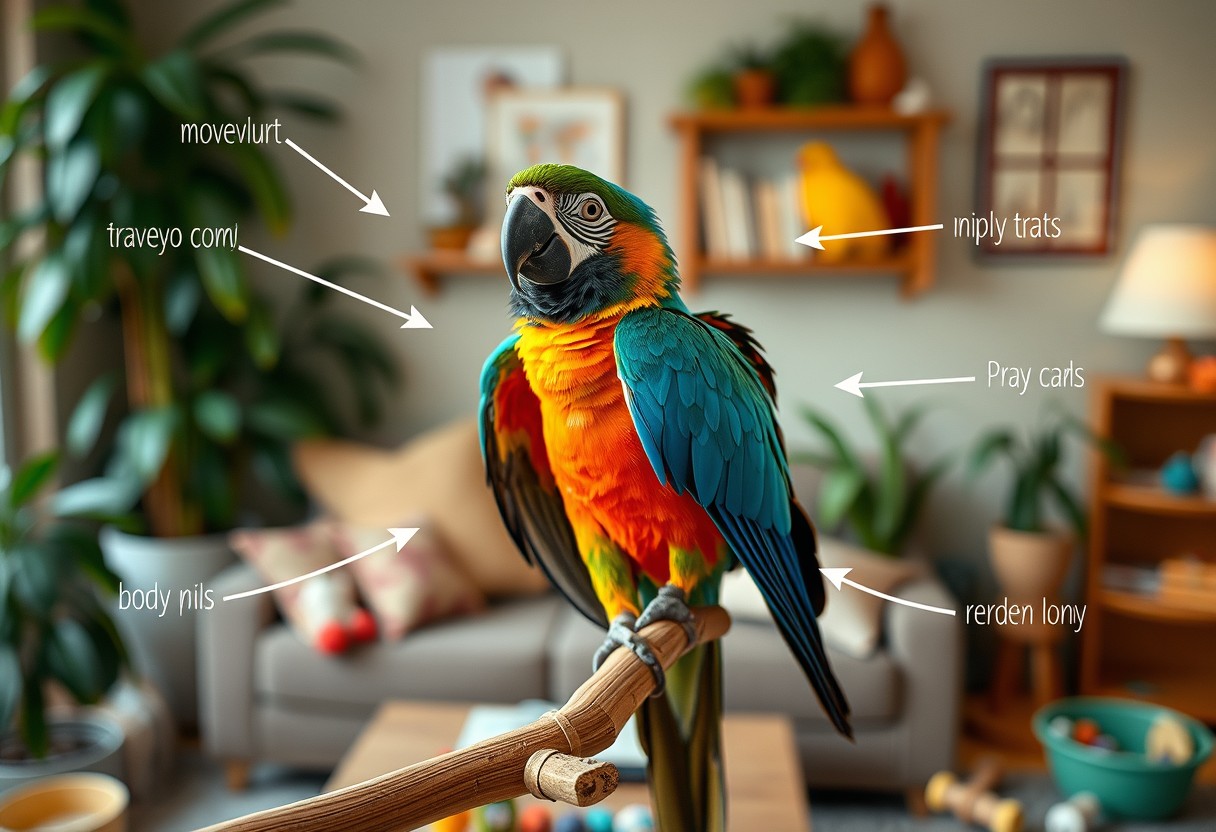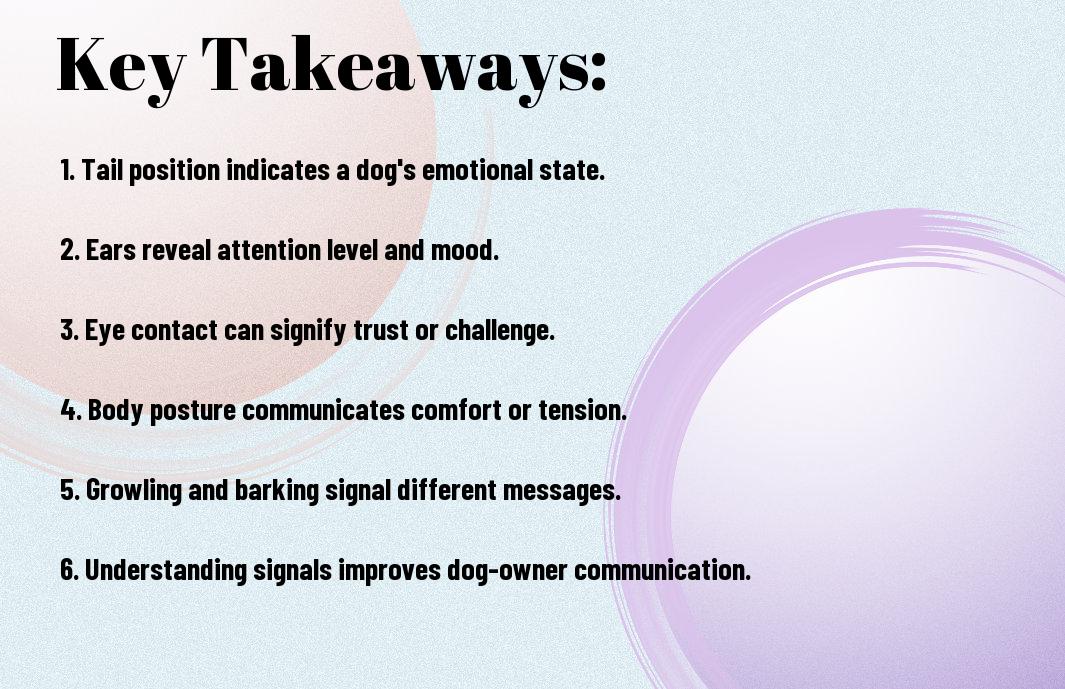Communication is key to a loving relationship with your pet bird. By understanding bird body language, you can decipher what your feathered friend is expressing, whether happy, stressed, or aggressive. Each gesture, from wing flapping to vocalizations, carries a meaning that will help you respond appropriately to their needs. This post will guide you through the various signals your bird uses, ensuring you’re well-equipped to enhance your bond and maintain a peaceful environment for both you and your pet.

The Importance of Bird Body Language
For pet owners, understanding the subtle nuances of your bird’s body language is vital in developing a strong bond and ensuring their well-being. Birds communicate not just through their chirps and calls, but also through their posture, movements, and facial expressions. Recognizing these signals empowers you to respond appropriately to your pet’s needs, whether it’s comfort, play, or space. Build a deeper connection by interpreting what your feathered friend is trying to express, fostering both trust and an enriched environment for them.
Why Understanding Body Language Matters
One crucial aspect to consider is that birds are prey animals by nature. This intrinsic trait makes them highly observant of their surroundings, and as a responsible pet owner, you must learn their body language to identify any signs of stress or discomfort. For instance, a puffed-up bird may be attempting to appear larger in the face of danger, while a fluffed-up but calm bird might be indicating they are comfortable and relaxed. By understanding these signals, you can ensure their environment is safe and accommodating, ultimately leading to a happier, healthier pet.
Common Misconceptions About Bird Behavior
Language around pet bird behavior is often clouded by misconceptions, which can lead to misunderstanding their true feelings or needs. For instance, many owners mistakenly believe that a bird screaming is always a sign of distress or trouble. However, loud vocalizations can also simply indicate excitement or a desire to communicate. Being attuned to these differences allows you to accurately assess your bird’s state of mind and respond accordingly.
Matters related to bird behavior often plague new bird owners, leading to unnecessary anxiety or misinterpretation of their pet’s actions. Another common fallacy is that a bird that refuses to engage with you is unfriendly or angry. In reality, birds can be shy or cautious, needing time to adjust to new environments or relationships. Understanding these misguided beliefs is key to fostering a positive dynamic with your bird. Embrace the journey of learning their unique body language, and you’ll enhance both your and your bird’s quality of life significantly.

Key Indicators of Bird Emotions
You may be surprised at how much your feathered friend communicates through their body language. Understanding these cues can enhance your bond with your pet and help you provide the best environment for their well-being. Below are necessary aspects to observe when assessing your bird’s emotions, including feather positioning, body posture, eye movement, and tail movement.
Feather Positioning
Feather positioning serves as a direct reflection of your bird’s emotional state. When birds are feeling relaxed and comfortable, they often display a relaxed feather configuration, appearing fluffed up and puffy. Conversely, if your bird’s feathers are tightly pressed against its body, this could be a sign of stress or discomfort. It’s necessary to remain observant of any sudden changes in feather fluffiness, which can indicate a range of emotions from contentment to fear.
Moreover, a bird that is preening its feathers can often be seen as self-soothing or engaging in a pleasurable activity. This behavior typically means your pet feels safe in their environment. However, if your bird shows excessive preening, it may signify anxiety or a need for more stimulation in their surroundings.
Body Posture
Any shift in body posture can be an necessary indicator of your bird’s emotional well-being. A bird that stands tall with an upright stance typically conveys confidence and assertiveness. In contrast, if you notice your bird crouching or hunching down, this behavior might indicate it is feeling threatened or vulnerable. Certain postures, such as leaning forward, may indicate excitement or curiosity, prompting you to engage with your pet more.
To understand your bird’s body posture, pay attention to the context. For instance, if your bird is perched with one leg raised, it could be preparing to take off or simply resting. Watching your bird’s interactions with its environment gives you a fuller picture of its emotional state and can guide you in providing better care.
Eye Movement and Pupil Size
Indicators of emotion can also be discerned through eye movement and pupil size. A bird’s pupils can dilate or constrict based on its level of stress or excitement. For instance, large, dilated pupils might suggest that your bird is feeling particularly excitable or alarmed. Conversely, a relaxed state is often indicated by normal pupil size, coupled with steady eye movements.
A close observation of your bird’s gaze can provide insight into its feelings; a bird that is frequently blinking may be comfortable or settled, while a bird that maintains a fixed stare could either be *focusing on* potential threats or feeling defensive.
Tail Movement
The tail is another body part that plays a significant role in communicating your bird’s emotions. The way your bird moves or holds its tail can convey happiness, annoyance, or fear. For instance, a tail held high and fanned out is typically a sign of excitement or contentment, indicating that your bird is feeling social and happy. On the other hand, a tail that is tucked or held close to the body might indicate defensiveness or discomfort.
Posture changes in the tail, such as rapid flicking, can also suggest a state of agitation or anxiety. If you observe this behavior frequently, it may be a sign of distress or irritation that requires your attention.

Behavioral Signals
Not all pet birds express their feelings openly, but by understanding the subtle behavioral signals they exhibit, you can learn to interpret what they are trying to communicate. Recognizing these signs is important for nurturing a strong bond with your avian companions. By observing their body language, you can better respond to their needs and create a more harmonious environment in your home.
Signs of Happiness
One of the most noticeable signs that your bird is content is their vocalization. Happy birds tend to chirp, sing, or mimic sounds with enthusiasm. You may also notice them engaging in playful behaviors, such as swinging on their perch or playing with toys. Their posture is another indicator; birds that feel happy often have their feathers clean and smooth, and they may exhibit relaxed body language, such as a slightly tilted head and an upright stance.
Additionally, a happy bird may display a willingness to interact with you—seeking your attention or readily approaching you for petting or head scratches. These signals reflect an overall sense of comfort and trust in their environment. Paying attention to these positive behaviors can help you foster a supportive and enriching atmosphere for your cherished pet.
Signs of Stress or Fear
With that in mind, it is equally important to recognize when your bird is feeling stressed or fearful. Signs of distress can include rapid wing flapping, aggressive vocalizations, or even a decreased desire to engage with you. You may notice your bird puffing up its feathers, becoming still, or hiding in the corner of its cage, all of which indicate discomfort or anxiety.
Another common sign of stress is if your bird exhibits abnormal behaviors, such as excessive preening or feather plucking. These actions can stem from underlying issues, such as a lack of enrichment, changes in routine, or environmental factors that are unsettling to your pet. Addressing these factors promptly can help alleviate their stress and enhance their overall well-being.
Indicators of Aggression
One of the most alarming behaviors you may encounter in your avian friend is aggression. Aggressive birds may lunge at you, hiss, or display their beaks in a threatening manner. You might also see their feathers ruffling, and their body may appear tense and puffed up. It’s vital to approach these situations with caution and understand that your pet may see you as a threat.
Signs that your bird feels threatened can include biting or a persistent attitude of defending their territory. Recognizing these indicators of aggression is crucial to addressing the underlying causes and ensuring a safe and welcoming environment for you both.
Social Bonding Behaviors
With the right nurturing, your bird can form strong social bonds with you. These behaviors may include preening you as a way of demonstrating affection or sharing food, which can signify trust and partnership. Look for signs of warmth in your bird’s body language as they lean towards you or settle on your shoulder, both of which indicate a sense of companionship.
Indicators of social bonding behaviors can also include vocalizations that mimic your voice or sounds that reflect contentment when you’re nearby. By encouraging these interactions, you contribute to the strengthening of your bond and understanding of their social nature.
Interacting with Your Bird
Once again, interacting with your bird is crucial for building a strong bond and understanding its needs and emotions. Each interaction you have can either strengthen or weaken the trust that your bird places in you. By observing and responding appropriately to your bird’s body language, you can create a nurturing atmosphere where your pet feels safe and secure. In this section, we will discuss how to establish a trusting environment, respond to your bird’s signals, encourage positive interactions, and recognize when professional help may be needed.
Creating a Trusting Environment
Birds are naturally cautious creatures, and it is imperative to create a habitat that makes your bird feel safe. Begin by offering a consistent routine, where feeding times, play sessions, and interaction follow a predictable schedule. This consistency can help your bird feel less anxious and more comfortable in your presence. Additionally, ensure that your bird’s living space is free from stressors such as loud noises, unwanted visitors, and other pets that might provoke fear.
Birds also thrive on positive reinforcement. When your bird exhibits calm and relaxed behavior, reward it with treats, praise, or gentle petting. Over time, your bird will begin to associate your presence with positive experiences, which will build trust and deepen your bond. Remember to be patient, as trust can take time to develop, particularly with birds that may have had negative experiences in the past.
Responding to Your Bird’s Signals
Your bird communicates in subtle but important ways, and it is your responsibility to interpret these signals correctly. Pay close attention to its body language, such as head tilting, wing flapping, or feather puffing. For example, if your bird nibbles gently at your fingers or approaches you with an upright posture, it may be seeking your attention and approval. Conversely, if your bird appears to be crouching or retreating, this could be an indication that it feels threatened and needs some space.
Understanding these signals helps you tailor your interactions to meet your bird’s needs. When your bird appears relaxed and content, take this opportunity to offer gentle affection, play, or training exercises. However, if your bird displays signs of stress, such as shrill calling or aggressive behavior, be sure to step back and give it the time it needs to become comfortable again.
Responding appropriately to your bird’s behavior not only fosters a more positive relationship but also helps prevent behavior problems down the line. Keep in mind, each bird is unique, and the more observant and responsive you are, the deeper your connection with your pet will become.
Encouraging Positive Interactions
On your journey to bond with your bird, fostering positive interactions is key. Create opportunities for fun and engaging activities that reflect your bird’s interests, such as teaching it new tricks or providing toys that promote physical activity. These interactions not only stimulate your bird’s mind but also enhance your relationship. Make sure to approach playtime and training sessions with a relaxed demeanor, as this will encourage your bird to engage with you willingly.
Incorporating regular socialization into your bird’s routine will also help. Even simple activities, like talking softly to your bird or allowing it to perch on your shoulder, can increase feelings of security and affection. The more your bird interacts with you and experiences positive reinforcement, the more it will seek your companionship.
For instance, you can set aside dedicated time each day for interactive play. This could involve games like searching for hidden treats or mimicking sounds together. Such activities not only enrich your bird’s life but help solidify your bond, making your bird feel more connected to you.
When to Seek Professional Help
Help may be necessary if you notice that your bird is exhibiting concerning behaviors that cannot be managed through your interventions. Signs such as excessive aggression, chronic screaming, or sudden changes in eating habits can indicate underlying health or behavioral issues. If your bird is constantly fearful or unresponsive, it may also benefit from the expertise of a professional.
Understanding when to seek help is an important part of responsible bird ownership. If you feel overwhelmed or unsure about your bird’s behavior, consider consulting an avian veterinarian or an animal behaviorist. Your bird’s health and happiness should always be your top priority, and professionals can provide invaluable insights tailored to your specific situation.
Your bird deserves a safe and nurturing environment, and by being aware of its signals and seeking professional help when necessary, you can ensure a happy, healthy life for your feathered friend. Keep in mind, building a loving relationship takes time and patience, but the rewards are well worth the effort.
Summing up
With this in mind, understanding your bird’s body language is an imperative aspect of nurturing a strong and effective bond with your feathered companion. By paying attention to the subtle cues, such as head tilting, tail feather positioning, and wing movement, you can gain valuable insights into your pet’s emotional state and overall well-being. Observing these signals not only allows you to respond appropriately to your bird’s needs but also enhances your ability to create an environment where they feel safe, happy, and engaged.
As you continue to decode your bird’s behaviors, you empower yourself to provide a better quality of life for your pet. By fostering clear communication and understanding, you are not just enhancing your relationship but also ensuring a richer, more fulfilling experience for both of you. Recall, your bird’s body language is an open book waiting for you to read and respond to its messages, making every interaction meaningful and enriching.
FAQ
Q: How can I tell if my bird is happy or content?
A: A happy or content bird often displays relaxed body language. Look for signs such as fluffed feathers, a relaxed posture, and playful behavior like chirping or singing. Additionally, content birds may engage in preening, showing that they feel safe and comfortable in their environment. A bird that is happily interacting with you, such as hopping towards you or offering its beak for gentle rubbing, is also exhibiting signs of happiness.
Q: What does it mean when my bird is puffing up its feathers?
A: Puffing up feathers can have a few meanings depending on the context. Generally, if your bird is puffing up briefly, it may be trying to warm itself or is getting comfortable while resting. However, if your bird maintains this posture while also showing signs of aggression, like a flared tail or loud squawking, it may be trying to appear larger in defense. Observing other accompanying behaviors will help you better understand the situation.
Q: How do I interpret my bird’s vocalizations in relation to its body language?
A: Vocalizations are a crucial part of understanding your bird’s emotions. Different sounds can signify various feelings; for instance, soft chirps and whistles often indicate happiness or welcoming behaviors, whereas loud squawking or screeching may express distress or anger. Pay attention to the body language accompanying these sounds—if your bird is moving its head or wings energetically while vocalizing, it’s likely expressing excitement or joy. Conversely, if your bird is huddled with feathers ruffled during vocalization, it may signal anxiety or discomfort.











